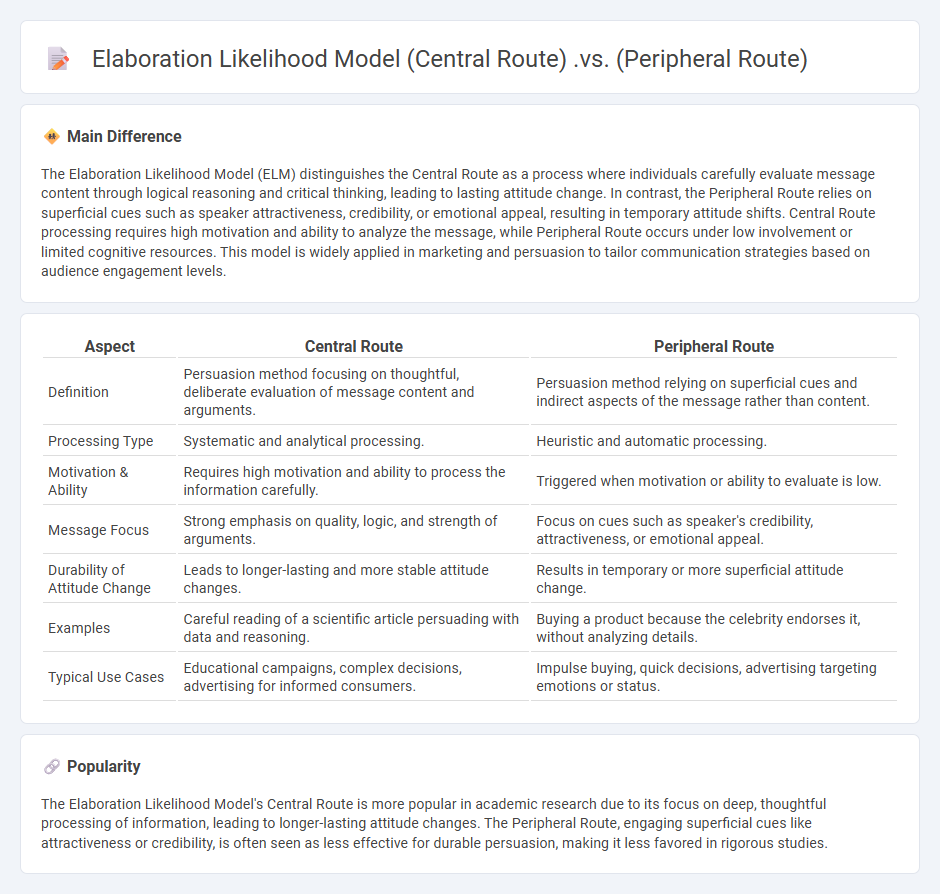
The Elaboration Likelihood Model (ELM) describes two primary pathways of persuasion: the Central Route involves careful and thoughtful consideration of message content, relying on logical arguments and evidence to influence attitudes. In contrast, the Peripheral Route depends on superficial cues such as speaker attractiveness, credibility, or emotional appeal, leading to attitude change without deep cognitive processing. Explore how understanding these routes enhances persuasive communication strategies.
Main Difference
The Elaboration Likelihood Model (ELM) distinguishes the Central Route as a process where individuals carefully evaluate message content through logical reasoning and critical thinking, leading to lasting attitude change. In contrast, the Peripheral Route relies on superficial cues such as speaker attractiveness, credibility, or emotional appeal, resulting in temporary attitude shifts. Central Route processing requires high motivation and ability to analyze the message, while Peripheral Route occurs under low involvement or limited cognitive resources. This model is widely applied in marketing and persuasion to tailor communication strategies based on audience engagement levels.
Connection
The Elaboration Likelihood Model (ELM) connects the Central and Peripheral Routes as dual pathways for processing persuasive information, where the Central Route involves deep, thoughtful evaluation based on message quality, and the Peripheral Route relies on superficial cues like attractiveness or credibility of the source. Both routes influence attitude change, but the Central Route tends to produce longer-lasting and more stable attitudinal shifts compared to the temporary effects of the Peripheral Route. The choice between these routes depends on factors such as the individual's motivation and ability to process the message.
Comparison Table
| Aspect | Central Route | Peripheral Route |
|---|---|---|
| Definition | Persuasion method focusing on thoughtful, deliberate evaluation of message content and arguments. | Persuasion method relying on superficial cues and indirect aspects of the message rather than content. |
| Processing Type | Systematic and analytical processing. | Heuristic and automatic processing. |
| Motivation & Ability | Requires high motivation and ability to process the information carefully. | Triggered when motivation or ability to evaluate is low. |
| Message Focus | Strong emphasis on quality, logic, and strength of arguments. | Focus on cues such as speaker's credibility, attractiveness, or emotional appeal. |
| Durability of Attitude Change | Leads to longer-lasting and more stable attitude changes. | Results in temporary or more superficial attitude change. |
| Examples | Careful reading of a scientific article persuading with data and reasoning. | Buying a product because the celebrity endorses it, without analyzing details. |
| Typical Use Cases | Educational campaigns, complex decisions, advertising for informed consumers. | Impulse buying, quick decisions, advertising targeting emotions or status. |
Attitude Change
Attitude change in communication refers to the process through which an individual's feelings, beliefs, or behavioral intentions toward a topic are altered through message exposure and interpersonal interactions. Research in social psychology highlights key theories such as the Elaboration Likelihood Model (ELM) and Cognitive Dissonance Theory, which explain mechanisms of persuasion and attitude adjustment. Effective attitude change strategies often involve source credibility, message framing, and audience engagement to achieve lasting impact. Studies show that communication channels like social media significantly influence public opinion and attitude shifts in contemporary settings.
Message Processing
Message processing in communication involves encoding, transmitting, receiving, and decoding information between a sender and a receiver. This process relies on effective channels such as verbal, non-verbal, and digital media to ensure accurate delivery of the intended message. Noise, including physical, psychological, and semantic barriers, can disrupt message clarity and reduce communication effectiveness. Advanced models of communication emphasize feedback mechanisms to confirm understanding and enhance message fidelity.
Cognitive Elaboration
Cognitive elaboration in communication refers to the depth of processing information during message exposure, impacting attitude change and message retention. High levels of cognitive elaboration engage critical thinking and analytical evaluation, often enhancing persuasion effectiveness in both interpersonal and mass communication contexts. This concept is central to the Elaboration Likelihood Model (ELM), which distinguishes between central and peripheral routes of persuasion based on the amount of cognitive effort involved. Effective communicators design messages that stimulate cognitive elaboration to foster sustained attitude change and stronger message impact.
Motivation and Ability
Motivation and ability significantly influence the effectiveness of communication by determining the transmitter's and receiver's engagement and comprehension levels. High motivation drives individuals to actively participate and process messages deeply, while strong ability ensures they can decode and understand complex information accurately. In organizational communication, motivated employees with adequate language skills and knowledge contribute to clearer message exchange and reduced misunderstandings. Studies indicate that tailored communication strategies enhancing both motivation and ability result in improved information retention and behavioral change.
Persuasion Cues
Persuasion cues play a critical role in communication by influencing attitudes and decision-making processes. Key cues include source credibility, message framing, and emotional appeal, which impact how recipients perceive and respond to information. Research by Petty and Cacioppo (1986) highlights the Elaboration Likelihood Model, explaining how central and peripheral routes mediate persuasion effectiveness. Understanding these cues enhances strategic communication across marketing, politics, and interpersonal interactions.
Source and External Links
Elaboration likelihood model - The model proposes two persuasion routes: the central route involves deep, thoughtful consideration of message arguments leading to lasting attitude change, while the peripheral route relies on superficial cues unrelated to message quality, causing more temporary attitude changes.
Elaboration Likelihood Model - Theories Of Attitude And Behavior Change - The central route is logic-driven and effective when the audience is motivated and analytical, focusing on message quality, whereas the peripheral route uses indirect cues like emotions or celebrity endorsements to persuade when motivation or ability to process is low.
Routes to Persuasion, Central and Peripheral - Richard E. Petty - Central route persuasion requires high elaboration and critical evaluation of arguments resulting in durable attitude change; peripheral route persuasion occurs with little thinking and depends on simple cues, often leading to more temporary changes.
 calledges.com
calledges.com